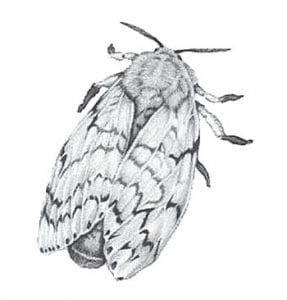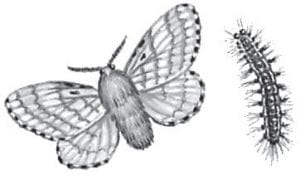Northlanders are becoming used to seeing little triangles of cardboard tacked to trees in the remotest of locations. After more than 10 years of gypsy moth monitoring, most people know that these are moth traps, put in place by the Minnesota Department of Agriculture (MDA). And most people have read about or seen the planes that fly over to implement the treatment intended to slow the spread of the destructive insect. This week MDA announced plans for treatment on the North Shore this spring and summer. Several public meetings will be held to provide information. Minimal treatment will be conducted in Cook County and the nearest informational meeting will be in Lake County. The reason for that, according to MDA’s Mike Schommer, is because treatment in previous years has been effective in the Arrowhead region.
“Based on the results of our monitoring, treatments conducted in Grand Portage and other areas appear to have been effective,” said Schommer in a March 1 phone interview.
Two types of gypsy moth treatment have been conducted in Cook County. A biological insecticide called Bacillus thuringiensis var kurstaki (Btk) was used in the Grand Portage area and mating disruption pheromones in other parts of the county. The mating disruption pheromones are dispensed on tiny plastic flakes. Both treatments are conducted aerially. Treatments are timed on the life cycle of the gypsy moth. Btk treatment is conducted early in the year, when the moths are in the caterpillar stage. Mating disruption pheromone treatment is conducted later in the summer because it targets adult moths, so treatments will take place sometime between late June and early August.
Two additional areas will be treated in Cook County in 2011 in the Tofte and Schroeder areas. The treatment area in Tofte is along the lakeshore and the Schroeder area abuts the Lake County border.
Schommer explained that the decision to not hold an informational meeting in Cook County was because it seems that local property owners are aware of the concern about gypsy moths and understand the treatment methods. He said, “We’ve been having open houses in Cook County for several years. People tend to have more questions in the first few years.”
Schommer said residents can find out when treatments are scheduled by visiting the MDA website at www.MDA.state. mn.us/gypsymoth or by calling the tollfree “Arrest the Pest” hotline at (888) 545- 6684.
Anyone who would like more information about gypsy moths is also invited to attend one of the upcoming meetings. The closest meeting is March 24 at Gooseberry Falls State Park Visitor Center, 3206 Highway 61, Two Harbors from 11 a.m. to 1 p.m. Gypsy moths (Lymantria dispar L.) are among the most destructive tree pests in North America, and they are well established from the East Coast to central Wisconsin. Gypsy moth caterpillars can defoliate large sections of forest, with oak, poplar, birch and willow among their preferred hosts. MDA monitors for the pests each year by attaching thousands of cardboard box traps to trees or poles around the state. In early fall, workers remove the traps and count the moths inside. When MDA finds a large number of moths in an area, it conducts treatments to eliminate the infestation or slow its establishment.




Loading Comments